A phenomenal custom cooler and abundant overclocking-friendly features.
Brad Chacos/IDG
Today’s Best Tech Deals
Picked by PCWorld’s Editors
Top Deals On Great Products
Picked by Techconnect’s Editors
EVGA GeForce RTX 3070 FTW3 Ultra
Show More
The GeForce RTX 3070 is a fantastic GPU, delivering face-melting performance on a par with that of the former $1,200 RTX 2080 Ti flagship for a stunning $700 less, as we covered in our comprehensive RTX 3070 Founders Edition review. Nvidia’s Founders Edition is a fine option if you plan to simply stick your graphics card into your system and get to playing. But if you want to push your hardware’s performance to the brink of what’s possible, consider EVGA’s GeForce RTX 3070 FTW3 Ultra.
Like the fantastic EVGA RTX 3080 FTW3 Ultra, this 3070 incarnation costs a steep premium—$610, versus the Nvidia FE’s $500—but you’re paying for every overclocking-friendly feature you could ask for. While Nvidia shrank the RTX 3070 Founders Edition design, which affected noise levels, EVGA stuck to a beefy 3-slot build for the FTW3 Ultra, using heavy metal to tame the Ampere GPU inside. EVGA supplemented the massive cooler with all sorts of tools that make it easier to top the 3DMark leaderboards, like dual BIOSes, several integrated temperature sensors to monitor various parts of the card, a dedicated fan control header, and more.
Does it make sense to spend over $600 on a loaded RTX 3070 when you can upgrade to the much more powerful RTX 3080 for just $100 more? And does AMD’s looming $579 Radeon RX 6800 change the equation? Let’s examine the EVGA GeForce RTX 3070 FTW3 Ultra.
EVGA GeForce RTX 3070 FTW3 Ultra specs, features, and design
Here’s a recap of the GeForce RTX 3070’s key technical specifications, compared against its direct predecessor, the $500 RTX 2070, as well as the $1,200 RTX 2080 Ti with which it trades blows in gaming performance.
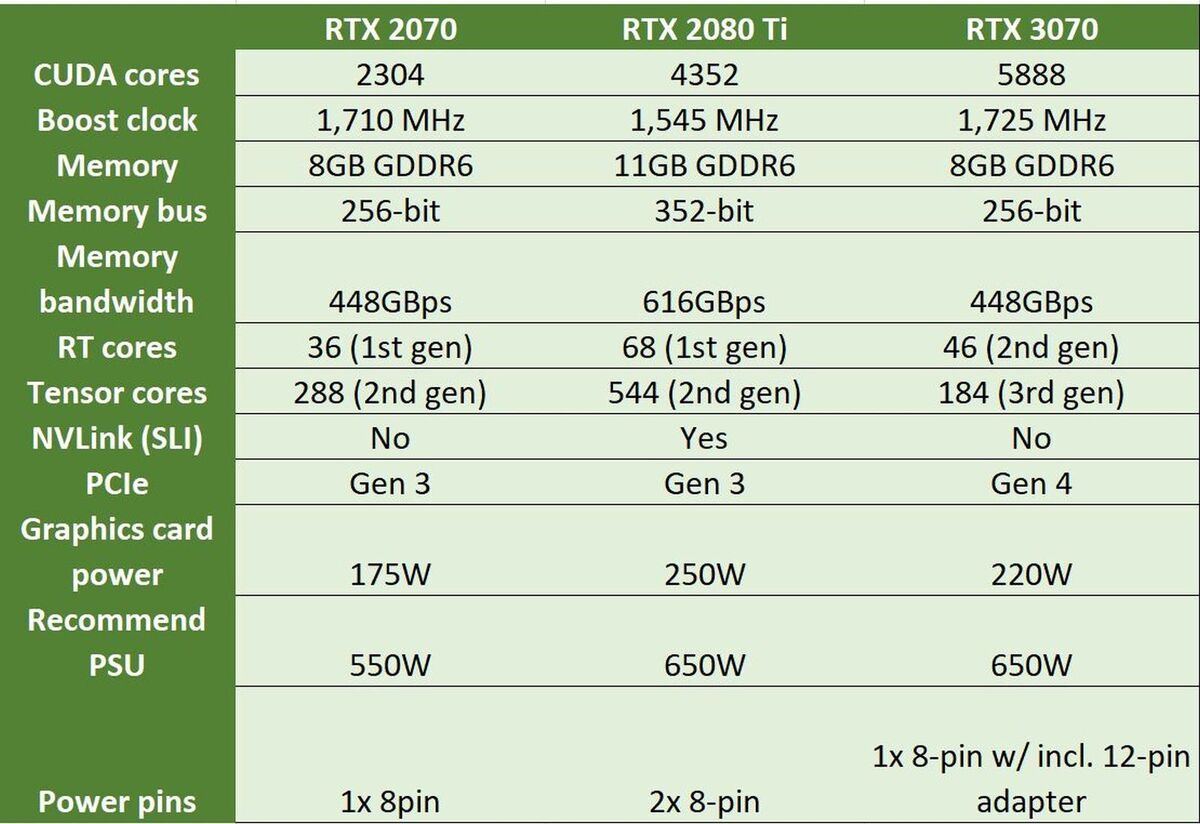 Brad Chacos/IDG
Brad Chacos/IDGEVGA changes only two key underlying technical specs with the RTX 3070 FTW3 Ultra, with the rest of its rejiggering dedicated to the cooler design and extra features. Most people will notice the increased clock speeds first. While the RTX 3070 reference specification hits a 1,725MHz boost clock, EVGA cranked the FTW3 Ultra up to 1,815MHz, a 90Hz increase. That gives it an out-of-the-box boost in gaming frame rates. It’s a small bump, but as you’ll see in our benchmarks section, it’s enough to move past the RTX 2080 Ti pretty much across the board—something that Nvidia’s Founders Edition couldn’t quite manage.
If you’re buying this card, though, you’re probably not planning to stick to stock speeds. Just as important to the FTW3 Ultra’s mission is its increased power requirements. Stock RTX 3070 cards draw 250 watts over a single 8-pin power connector, coming from a recommended 550W power supply. In its quest for overclocking glory, the FTW3 Ultra bumps that up to a pair of 8-pin power connectors and recommends hooking the card up to a sturdier 650W power supply. (There’s no need to fiddle with ugly 12-pin adapters like you do with Nvidia’s Founders Edition, however.)
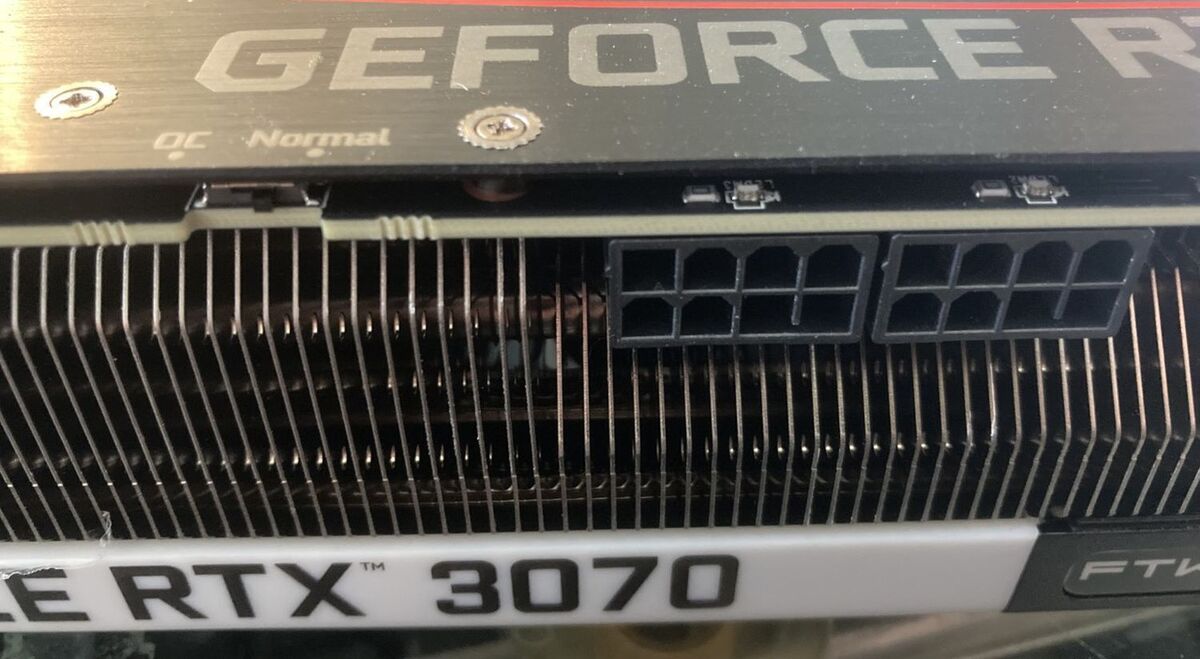 Brad Chacos/IDG
Brad Chacos/IDGThe dual-BIOS switch is to the left of the dual 8-pin power connectors.
EVGA puts the power to good use. This custom card ships from the factory with a higher 275W power limit enabled. Overclockers can crank the power limit up another 11 percent (to 305W) in GPU software like’s EVGA’s stellar Precision X1. Modern Nvidia GPUs get faster when you feed them more power, and like EVGA’s other FTW3 options, the 11-percent power limit increase is probably higher than what you’ll see in most rival custom RTX 30-series GPUs.
EVGA stuck with a gargantuan triple-slot cooler in its quest for overclocking supremacy. The FTW3 Ultra measures 11.8 inches long and 5.4 inches wide, and a chunky three slots thick.
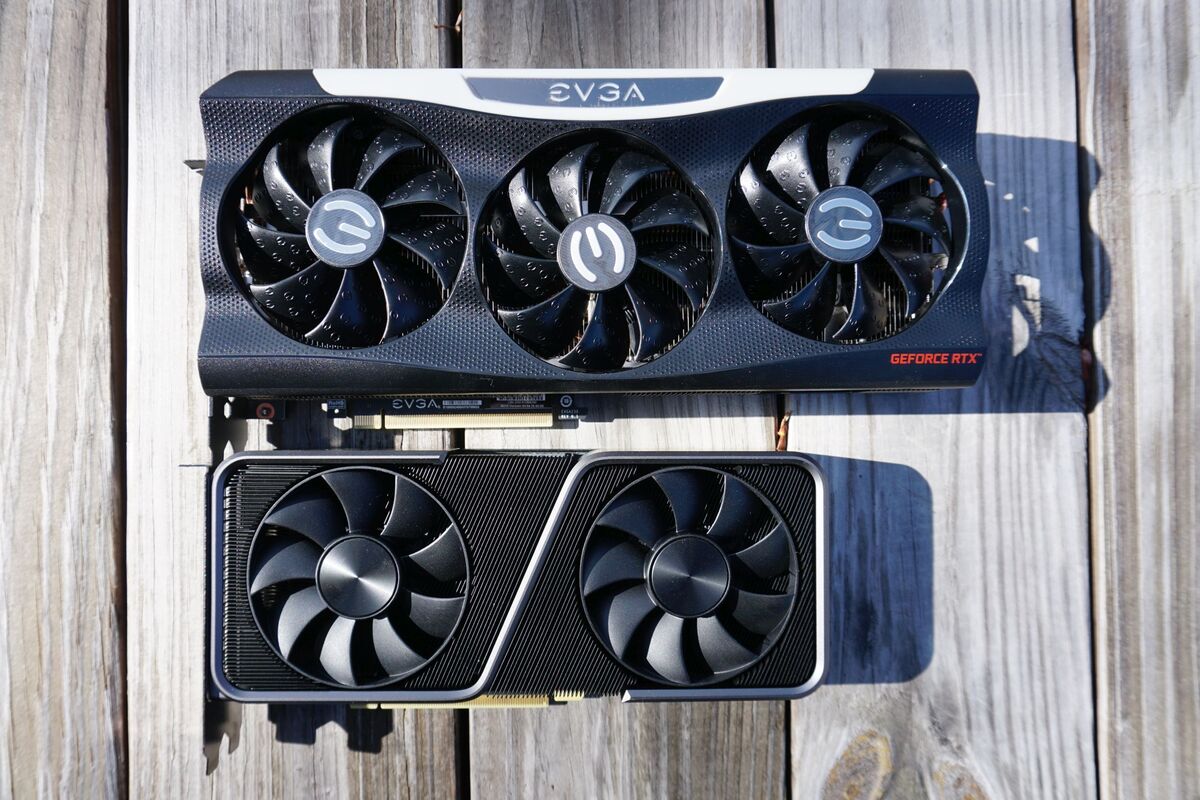 Brad Chacos/IDG
Brad Chacos/IDGThe EVGA FTW3 Ultra is much larger than Nvidia’s RTX 3070 Founders Edition.
The design largely (but not exactly) mirrors the custom cooler included with the step-up RTX 3080 FTW3 Ultra, which we covered in depth in our review of that card. In brief, the RTX 3070 FTW3 Ultra includes a massive heat sink infused with multiple copper heat pipes. EVGA says it redesigned the heat sink to allow air to move more freely throughout, then matched that with cut-outs in the custom PCB and aluminum backplate to let air flow through the card (perhaps in a nod to the Founders Edition’s unique flow-through design).
It’s topped by three large second-generation “HDB” fans in its wavy shroud. They won’t kick on until the GPU becomes stressed, creating a silent desktop experience. Each fan is independently controlled to better react to the temperature needs of the hardware directly underneath it.
 Brad Chacos/IDG
Brad Chacos/IDGThat fine-grained temperature control is a key selling point for EVGA’s graphics card. Most GPUs only report singular measurements for GPU and maybe VRM temperatures. The RTX 3070 FTW3 Ultra packs not one, not two, but nine additional iCX3 sensors embedded throughout the card, letting you see temperature readings for different parts of your GPU, memory, and voltage regulation systems. EVGA introduced iCX technology in the GeForce GTX 1080 Superclocked 2 following a (mostly overblown) cooling controversy. It remains a killer exclusive feature for graphics card nerds. If you’re overclocking the FTW3 Ultra to its limits in a bid to top competitive leaderboards, the iCX sensors are an invaluable resource. It’s less useful (but still cool) if you aren’t into hardcore tinkering.
Bottom line, though? EVGA’s substantial custom cooling solution rocks when bolted onto the RTX 3070. Nvidia’s Founders Edition card maintained a chilly 72 degrees Celsius under load, but EVGA’s card never topped an absolutely frigid 62 degrees even under extended duress.
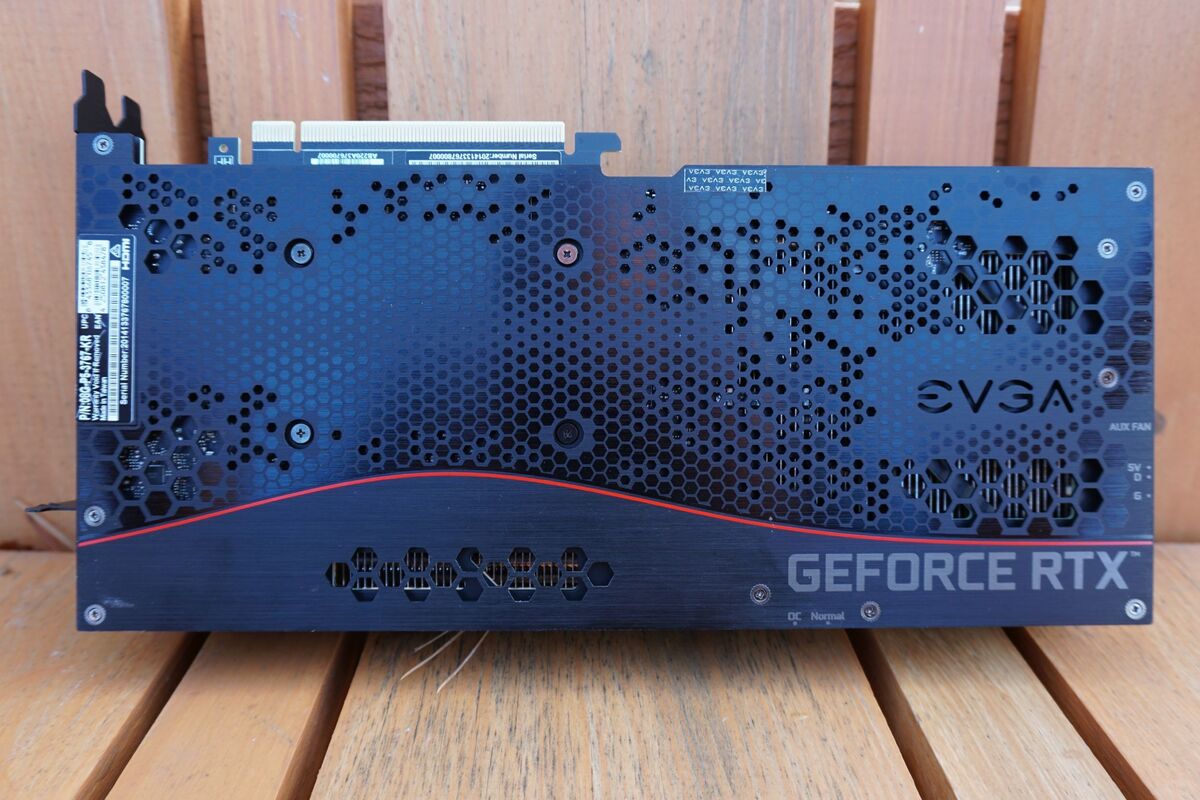 Brad Chacos/IDG
Brad Chacos/IDGThe EVGA FTW3 Ultra also includes a metal backplate.
There are more welcome extras for overclockers as well, including a dual-BIOS switch on the edge of the card. We test with the stock BIOS, but the secondary “OC” BIOS increases fan speeds to reduce temperatures and give Nvidia’s GPU Boost feature more thermal headroom to potentially hit higher clocks. That’s handy as-is for people who prefer one setting or the other, but a dual-BIOS switch is precious for overclocking. If you push things too far with an overclock and lock up your system, being able to flip a switch to a secondary BIOS to get back in and start troubleshooting is a godsend.
EVGA also equipped the FTW3 Ultra with a PWM fan header on the end of the card. You can plug one of your case’s PWM fans into it and have the fan be intelligently controlled directly by the graphics card’s temperature, rather than by your motherboard. Rival graphics cards like Asus ROG Strix have offered this before, and it’s most useful if you use your card to control a front case fan pointed directly at the GPU. Next to the fan header, you’ll find an ARGB header that you can plug into your motherboard to tie it together with your graphics card’s chosen lighting.
Both features can be controlled via EVGA’s clean, easy-to-use Precision X1 software, which also provides access to iCX monitoring, an on-screen display that shows vitals during gaming, and overclocking controls—including an easy-peasy OC Scanner tool for modest one-click overclocking tied to your specific GPU’s particular capabilities.
 Brad Chacos/IDG
Brad Chacos/IDGThe 3080 FTW3 Ultra’s light strip (top) blends more thoughtfully into the card’s design than the 3070 FTW3 Ultra’s strip (bottom) when the lighting is disabled.
Like its 3080 sibling, the EVGA GeForce RTX 3070 FTW3 Ultra features a large, enthralling RGB light strip along it edge. The color of the RGB strip when you have the RGB off looks different—worse—on the RTX 3070 version, though. On the RTX 3080 FTW3 Ultra, the strip looks metallic, with EVGA and GeForce logos emblazoned on it in white letters. The 3070 version flips that, using dark letters against a milky-white translucent strip. I’m not a fan. The 3080 FTW3 Ultra looks beautiful with the RGB lights on or off, but that white chunk sticks out like a sore thumb on the otherwise dark 3070 FTW3. It’s gorgeous when illuminated, though.
Speaking of aesthetics, it’s worth noting that our 3070 FTW3 Ultra still includes the…controversial…red trim on both ends of the card, which definitely looks out of place on this design. EVGA tells me that all production models that hit the streets will have black trim instead. Hallelujah.
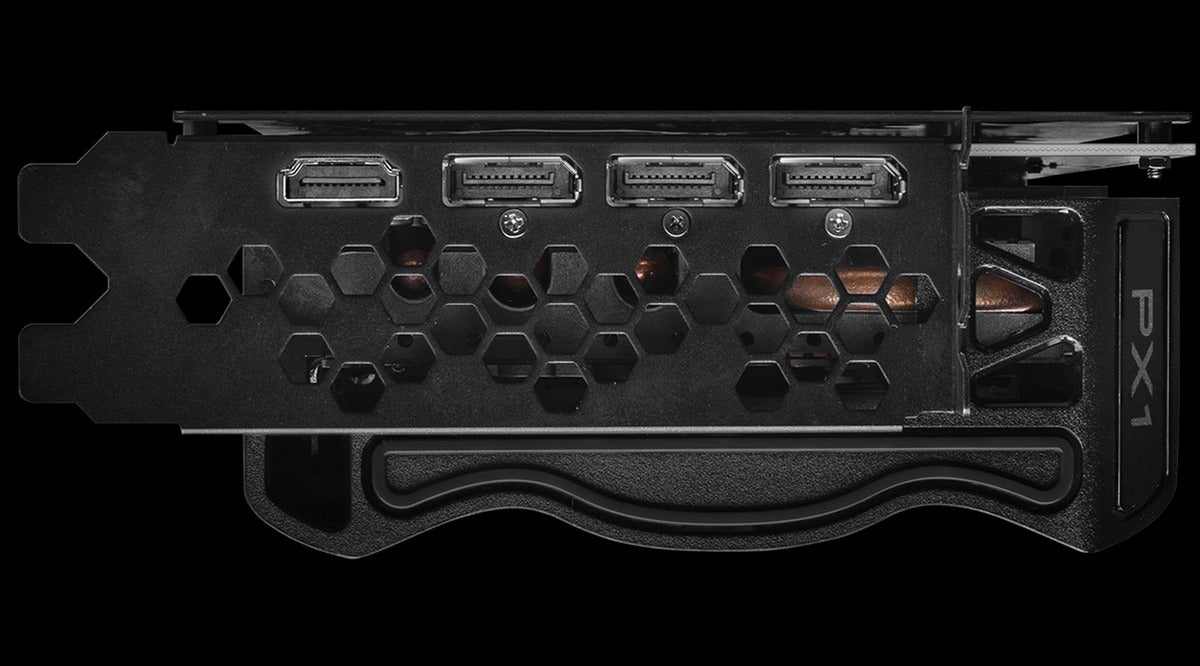 EVGA
EVGAAdios, red trim, hello port report
That plays into another reason to consider this card: EVGA is known for being very responsive to customer feedback. The company gets high marks around the web for its stellar customer service and EVGA Step-Up Program, and it won the hearts of enthusiasts in recent weeks when it instituted a queue-based system for orders on its RTX 3080 and 3090 offerings, in the face of ongoing overwhelming demand for Nvidia’s new GPUs.
As an RTX 30-series GPU, the FTW3 Ultra also supports AV1 decoding, HDMI 2.1, Nvidia Reflex, RTX IO, Nvidia Broadcast, Shadowplay, and more. Check out our RTX 3080 Founders Edition review for a fuller list of GeForce features.
But enough design talk. Let’s get to the benchmarks.
Next page: Our test system, gaming benchmarks begin
EVGA GeForce RTX 3070 FTW3 Ultra
EVGA’s GeForce RTX 3070 FTW3 Ultra sports a phenomenal custom cooler, a factory overclock, and abundant overclocking-friendly features. It’s an excellent high-end RTX 3070 option, but the price is steep and the card is massive.
Pros
- Excellent 4K and 1440p gaming
- Phenomenal custom cooler: Frigid and silent
- Loaded with overclocking-friendly features
- Fan and RGB headers, striking RGB lights
- Precision X1 software is superb
- Ray tracing at 1440p and (sometimes) 4K
Cons
- 8GB of memory doesn’t feel future-proof for 4K gaming
- Massive size
- Steep premium for luxurious features; might be worth upgrading to 3080 instead


